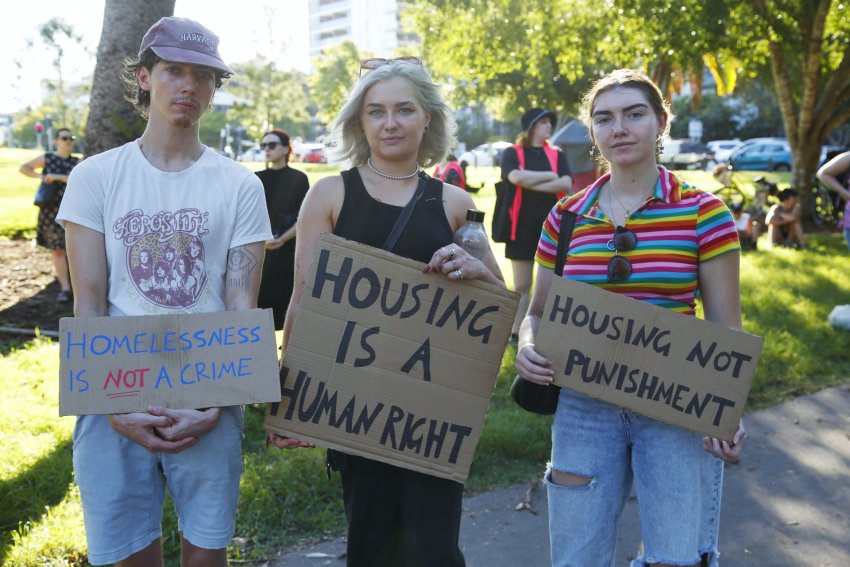
The Queensland Child Death Review Board’s recent report on the 53 children who died in 2023–24 and were know to the Queensland child protection system, one died by suicide in a box on the street after the Department of Child Safety banned them from residential care facilities and gave them a tent to live in.
The Brisbane City Council (BCC) and the Moreton Bay Regional Council (MBRC) must consider this and abort plans to evict and displace homeless individuals living in tents in the Magan-djin/Brisbane region.
Brisbane Lord Mayor Adrian Schrinner announced on March 13 that the BCC would evict rough sleepers from public parks, especially Musgrave Park. This follows MBRC’s decision, in February, to make homelessness “illegal” on public land, which took effect on March 12.
Activists called an emergency action in Musgrave Park on March 14 and 16, with more than 400 people joining a rally and a planning meeting.
People who have survived homelessness told the rally that it is not a “choice” and that nobody sleeps in a tent in a park if they have a better option.
Caspian Bahramshahi-Willet from the Anti-Poverty Network said that Schrinner is “wrong” to think this "aligns with Brisbane values”. Jonathon Sriranganathan, a former BCC Greens Councillor, said the police should not be called to move rough sleepers on.
The rally resolved to protest outside a council meeting on March 18 and another action is planned for March 28.
The BCC’s mistreatment of homeless people is not new: council workers were taken to task in 2023 by Northwest Community Groups for confiscating and binning tents which had been provided to homeless people only days before.
What is new is both councils’ frankness. Despite the cost-of-living and housing crises, they have decided to scapegoat the vulnerable rather than find solutions to homelessness. Since late last year, both have doubled-down to displace and evict of rough sleepers in tents.
In February, MBRC used police to evict rough sleepers from Sutton Park and Gayundah Arboretumonm. Many were not offered temporary accommodation.
In March it declared homelessness a crime. Many moved to areas covered by BCC to avoid fines, but they risked $8065 fines if they pitched tents in public parks. Schrinner also committed to evicting all homeless individuals from parks within 24 hours, saying most are “homeless by choice”.
Last August, MBRC threatened to deploy police to forcibly remove homeless individuals from Woody Point for the Moreton Bay Food and Wine Festival.
Last October, BCC cut power to Kurilpa Point Park and Musgrave Park, leaving inhabitants without barbeques and electricity.
MBRC banned homeless individuals from keeping pets or sleeping in vans on public land on December 12. It changed its definition of homelessness and created new fines of up to $8065.
Politicians respond
Moreton Bay Mayor Peter Flannery said homeless individuals are “abusing” council frameworks and that charities are “enabling homelessness” by “providing free meals and equipment”. He said council would no longer be “lenient”.
Liberal-National Party Councillor Adam Hain told The Guardian: “We just became the soft touch. I mean a lot of these people have got smartphones”.
Academics and housing specialists are speaking out against the councils’ actions.
Dr Katie Hail-Jares said MBRC’s aim is to make the homeless population a BCC issue. “Nimbyism really is not about fixing the issue or trying to alleviate people’s experiences of harm. It’s really just about making it someone else’s problem.”
Micah Projects CEO Karyn Walsh was also critical. She said Schrinner’s assertion that people choose to be homeless is wrong.
“While 261 people were registered as sleeping rough during the cyclone [Alfred] there were 146 people who weren’t eligible for accommodation because they had no form of identification.
“There were 115 people who did have identification but only 71 were offered accommodation.”
Revealingly, housing minister Sam O’Connor told ABC News: “We don’t have the capacity right now with the lack of delivery of social and affordable housing over the last decade to offer homes straight away to people in parks.”
1 million homes vacant
According to the most recent census there were 1 million vacant homes in 2021.
Viva Hyde reported in the Courier Mail last June that, in Magan-djin alone, “an average of 34 percent of homes were unoccupied in [its] top 20 suburbs with the highest percentage of empty dwellings on Census night.”
According to the Australian Bureau of Statistics an estimated 122,494 people were experiencing homelessness. That number would only have risen.
The evidence is clear: the number of homeless people across the country is dwarfed by the number of unoccupied homes.
Australia doesn’t have a housing crisis. We have a tenancy rights crisis and a problem with policies making housing a capital gain rather than a human right. Neither major party has the political will to address the elephant in the room: change the tax laws to prohibit housing speculation.